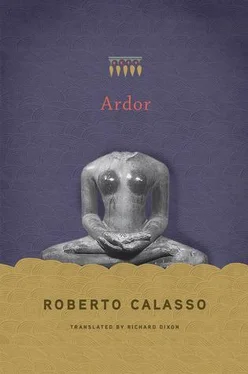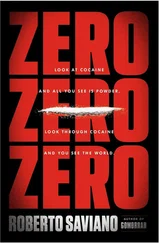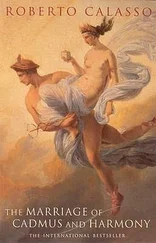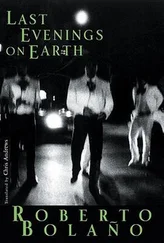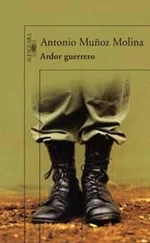Man is the only flayed animal. And not just by nature — at one time he too had a skin — but because the gods, at a certain point, decided to flay him and give his skin to the cow. This is the true story of primordial times — the story to which men were forced to go back when they began to eat the flesh of the cow and also to flay it. To justify himself, man had to keep alive the memory of a time when he was an animal like so many others, protected like all of them by a skin. Then he became a single sore: “Having been flayed, man is a sore; and, by anointing himself, he is healed of his soreness: because the skin of the man is on the cow, and even fresh butter comes from the cow. He [the officiant] supplies him with his own skin, and for this reason [the sacrificer] has himself anointed.” In his state of dereliction, this being who no longer has any defense from the world regains his own skin through the butter that anoints him: with that beneficial anointment the cow gives back to man something of what it has received from him. It follows, among other things, that man is a sort of outcast of nature. A blade of grass is enough to make him bleed. His only possibility of survival, and of saving himself from that excess of suffering which is his lot, is through artifice: the anointment that covers his body, the clothes that form a new skin. At that point, thanks to the powerful catapult of practices ignored by every other being, man can return to mingle with nature. But he must not appear naked in front of the cow: the animal would remember the cruel story of what had happened and would run off, fearful of losing its beloved hide. The cow flees from man not just for fear of being flayed, but because man — a flayed being — might try to take back his skin, which now adorns the cow. There is an unaccountable embarrassment when a naked human body finds itself among animals: a feeling that is difficult to deny, but on which no attention ever appears to have been focused. For the Vedic ritualists, however, it was the mark of distant and painful events that had left a mark in the rite. And above all, it was the recollection of the only possible way to justify relations with these mild animals that were close to human life through rain, heat, and ice. At the same time it should be added that, in the long history that separates the Vedic ritualists from Beau Brummell, never has such a clear-sighted explanation been given for the importance of dress. And never has a more convincing justification been offered for the peculiar embarrassment people feel about nudity.
Vedic India is the only place, throughout world history, where the following question has been asked: why is it true that “man should not be naked in the presence of a cow”? People seem to have had no concern about the question, either in ancient times or today. But the Vedic ritualists did. They also knew the answer: because “the cow knows it is wearing his [man’s] skin and runs away for fear that he might want to take it back.” And they then add a note of charming frivolity, based on another disconcerting observation: “Cows are therefore trusting when they approach those who are well dressed.” Perhaps only Oscar Wilde, had he known it, would have been able to comment with authority on this reason for dressing well.
As for the Vedic ritualists, they gave it credence through a story that others would one day have called a myth, but which in their words sounded like a dry, anonymous account of how things began. Everything started when the gods, watching events on earth, realized that the whole of life was supported by the cow. Men were its parasites. One of the gods — we don’t know which — urged humans to allow their skin to be used to cover the cows. So the gods flayed man. If we try to go back to the very beginning, this is therefore the natural human state: the Flayed Man, as in sixteenth-century anatomical drawings. Unlike the naïve positivists, who presented primordial man in natural history museum display cabinets with a monkey-like covering of hair, the Vedic ritualists saw him not as the mighty lord of creation, but as the being who was most exposed, most easily vulnerable from the world outside. For them, man didn’t just conceal a wound, but was a single wound. They wanted to add an eloquent detail: man is a hemophiliac by vocation, as even a blade of grass can make his blood gush forth.
Among the many characteristics that distinguish man (depending on the point of view: he is the only one who speaks, the only one who laughs, the only one who cries, the only one who celebrates sacrifices), the fact that he is the only creature who feels the need to dress is generally seen as the clearest sign of his inextricable link with artificiality. But, here again, the Vedic ritualists thought differently — and refuted in advance all those who came later. According to them, when at the beginning of the rite of “consecration,” dīkṣā (which is also an initiation), the sacrificer wears a linen robe, at that moment “he wears his own skin.” Only then does man regain his “completeness.” Only then does he return to that which was his original state.
This is a complete reversal of the current view: here artifice indicates the reconquering of nature as something whole. But it is still a temporary reconquest since, at the end of the liturgy, man will have to free himself of all the objects (and garments) he has used during the rite, thus returning to his condition of being impure and flayed. Naturalness is a temporary state, linked to a garment and a certain sequence of gestures (the rite).
* * *
Anointing was one of the most frequent gestures in rituals, in places far and wide, right up to the ceremony that consecrated Western kings. But none of the explanations given for it is as wild as the one offered by the Vedic ritualists. It presumes that man starts off, not from nothing, but from less than nothing. His original condition is not just that of an impure being, immersed in untruth. In the beginning, man doesn’t even have his whole body. Before he begins to act, someone has acted on him, flaying him. Man, in the beginning, is therefore a single sore. The wound, for him, is not one injured part of his body, but the totality of his body. The anointment covers this edgeless wound with a soft, wet, invisible film that makes movement and life possible. To understand the immensity of the ritual work, and its meticulous obsessiveness, it has to be placed in the context of this human condition at the very beginning, which is one of complete helplessness and pure pain. And only this can justify it.
* * *
If people at the very beginning (in other words, people who had not yet instituted sacrificial rites) were flayed and suffering beings, lacking in “completeness,” the decision to kill oxen and cows could only seem like a blasphemy. They looked upon those tame and mighty animals who grazed everywhere, protected by their magnificent hide, as a living provocation, rather like certain rich people who flaunt jewelry bought at auction from families that have fallen on hard times. Wrapped in improvised clothing, so as not to raise suspicion, men approached the animals and killed them. They had decided to put an end to the lives of those beings who until then had been a support for life itself. Sacrifice, the theory and practice of sacrifice, was a long, exasperated, captious, daring reworking of that gesture into actions, into formulas, into chants. People now went about in linen robes: it is said that the warp and weft of the cloth belonged to Agni and Vāyu and that “all the divinities had a part” in producing them. The same gods who had flayed them in the first place now took pains to protect them.
* * *
The most widespread objection to modern vegetarianism goes like this: you avoid eating beef, but the hides are used to make your shoes, your belts, your clothes. How can you be consistent in claiming to condemn the killing of these animals, which is also being done to clothe you? There is no convincing solution to this question — and the answer given by those who declare they wear only cord or plastic shoes or cloth or metal belts is simply pathetic. The industrial production cycle is much more sophisticated — and there is no way of totally avoiding contact with the secondary products of meat slaughter.
Читать дальше
